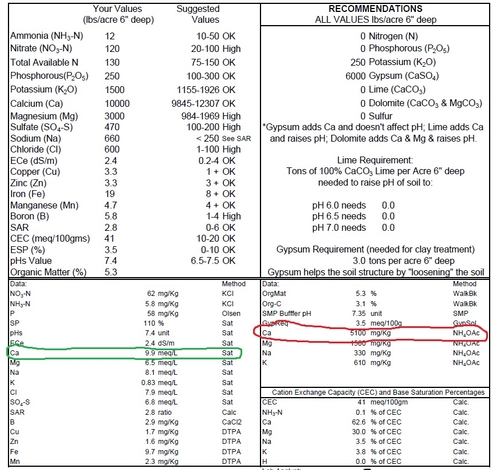
Posts Tagged: calcium
Sodium Adsorption Ratio (SAR), Briefly
I look at a lot of soil reports these days, and the sodium adsorption ratio (SAR) is one number that is very informative to me.
Simply put, SAR of a soil extract takes into account how much the adverse effect of sodium (Na+) is moderated by the other cations calcium (Ca2+) and magnesium (Mg2+). As you all know, calcium and magnesium can replace sodium on soil particles, subsequently permitting this toxin to be washed away from the plant roots. So the more free calcium and magnesium we have around in the soil, the better odds we have of mitigating sodium.
SAR levels below 6 are OK, levels which run above 10 mean trouble.
Although most soil reports will give you a calculated value for SAR, you can calculate SAR yourself. It's simple: SAR = Na+/((1/2(Ca2+ + Mg2+))1/2 ), where Na+, Ca2+ and Mg2+ are all measured in meq/L (milliequivalents per liter).
Quick Tip on Interpreting Calcium Results on Soil Analyses
Another short summary from the Fertility Short Course held by Tim Hartz and Stuart Pettigrove at UC Davis this past fall.
Calcium (Ca) has an important role in plant nutrition, but we tend not to pay too much attention to it because rarely is it an issue in berry health on the Central Coast. As outlined further on in this post, it's because we have so much of it already in our soils here.
Crop uptake of calcium is in the range of 100- 300 lb per acre, which means having a soil test like the one below with something around 5100 ppm has a potential supply of 10,200 lbs of Ca per acre (5100 PPM x 2 = 10,200 lbs/A) in the top 6” of soil apparently is well excess of what is needed.
Then again, we know that all the Ca removed in this ammonium acetate (NH4OAc) extraction is not all available to the plant because it can be tied up on soil particles, organic matter, colloids or precipitated out as Ca compounds.
A saturated paste analysis like the one on the left of the soil test below (circled in green) is the way to address what is really available to the plant. Results are most commonly given in meq/l, meaning milliequivalents per liter solution.
To get a feel for the Ca availability that we see on our saturated paste soil results, bear in mind that hydroponic solutions for greenhouse or substrate production, which are formulated for optimum crop growth and production, are 4-8 meq Ca/liter, and comprise 30-50% of the total cation meq. Comparing this ideal formulation with a survey (see link below) of representative crop production soils in coastal and central California which found of average of approximately 6.6 meq/liter Ca (assuming a 5:1 ratio soil solution/saturated paste and equivalent to 660 ppm Ca) and represented 55% of the cation milliequivalents. This amount, roughly calculated out, arrives at 600 lb Ca in soil solution. To reiterate from the above, crop removal is around 100-300 lb per acre, so this gives us a lot of confidence that we really have ample Ca around here for our berry crops.
Thinking through this to its practical application in the field, compared to the large amounts of calcium already available in our soils, fertilizer additions of calcium don't really add that much at all. For example, the “calcium kick” from a fertilizer like CAN-17 (12.3 lb/gal, 8.8 % Ca, so a 3 gal/A application simply adds 3.25 lbs of Ca/A - a mere drop in the pool of 600 lbs already there for the plant) isn't much of a kick at all.
Here is the excellent link discussing calcium availability in coastal and central California soils referred to in this post :
http://www.cdfa.ca.gov/is/docs/04-0701Hartz%2007.pdf

Soil sample from strawberry field taken last year. Potential calcium supply is 5100 ppm on the right and circled in red, and saturated paste, a measure of calcium availability, is 9.9 meq/l, is on the left circled in green.
Interesting Case of Salt in Coachella Valley
You may have noticed I've changed the title of this post. I talked with Michael Cahn from UCCE Monterey and yes, that is salt on the surface of this soil, and its pretty impressive and all, but this stuff is pretty likely calcium carbonate or calcium sulfate which precipitate out pretty easily and present less harm to the plant than something like sodium or chloride.
So it's still a salt, but not one which is super harmful to the plants. Lots of you are seeing this white stuff on the bed tops and furrows right now, again it's most likely calcium carbonate or calcium sulfate. More to come on this subject later.

Eggplant planting in the Coachella Valley. White material in the furrow is very likely calcium carbonate or calcium sulfate, which are salts.
Base Cation Saturation Concept: Does the Ca:Mg Ratio Affect Crop Yields?
There are two ways to interpret soil testing of the cations calcium (Ca) and magnesium (Mg), from the field: one by basic cation exchange ratios and the other by sufficiency. Base cation saturation ratios appear in most soil reports (see area circled in red below) and consist of percentages of calcium, magnesium and also potassium, sodium and hydrogen. Tim Hartz from UC Davis addressed this topic head on at the recent UC Soil Fertility Short Course held on October 23.
Proponents for examining cation ratios, for example Albrecht and Stiener, have held that there is an ideal cation ratio, meaning that the optimum soil environment for crop plants occurs when the cation exchange complex is 65% Ca : 10% Mg : 5% K : 20% H. To some extent this makes sense, since it has been shown that the base saturation of an individual cation can affect its availability to plants and that the uptake of one cation may affect the uptake of others.
However, research testing a variety of ratios of cations in the soil, especially Ca and Mg, has not found much in the way of identifying a true ideal ratio. As an example given at the short course in Davis, a study in Wisconsin that doubled and even quadrupled the exchangeable Ca: Mg ratio resulted in no difference in yield of alfalfa hay per acre.
It was rather suggested that growers and managers should concentrate on making sure each nutrient is in sufficiency for plant uptake rather than on reaching some favorable cation saturation ratio.
Most California soils have an abundance of calcium and magnesium in them already. In the soil test shown below, which is from a representative raspberry soil of the Pajaro Valley, we have 4100 ppm (mg/Kg) of calcium and 670 ppm magnesium, which when we multiply times two equals 8200 lbs of calcium and 1340 lbs of magnesium in the top 6” of soil, compared to the approximately 100 lbs of calcium and 25 lbs or so of magnesium that we need for a decent berry crop. We have A LOT of calcium and magnesium in our soils.
Moreover, it’s pretty expensive to try and alter the calcium and magnesium ratios of a soil. For example, more than 1700 lbs of gypsum will be needed to be added per acre to raise the calcium by 20 ppm. So, outside of extreme misbalances of calcium and magnesium which result in structural problems like crusting, it’s probably not worth the effort and money to obtain a ratio which doesn’t seem to offer anything extra in the way of nutrient sufficiency.
In conclusion, the truth of the matter is really that even though cations do compete with another for plant uptake and have different effects on soil structure, it is nevertheless completely possible to have high plant productivity with a wide range of ratios of calcium to magnesium.
The link below is an article with a full discussion of the concept of soil cation ratios.
http://www.soils.wisc.edu/extension/wcmc/2004proceedings/Kelling1.pdf

mpbolda145
Got calcium? Mineral key to restoring forests
Calcium can do much more than strengthen bones. The mineral is a critical nutrient for healthy tree growth, and new research shows that adding it to the soil helps reverse the decades-long decline of forests ailing from the effects of acid rain.

“It is generally accepted that acid rain harms trees, but the value of our study is that it proves the causal link between the chronic loss of soil calcium caused by decades of acid rain and its impact on tree growth,” said Battles. “The temporal and spatial scope of the study – 15 years and entire watersheds – is unique and makes the results convincing.”
The researchers reported that trees in the calcium-treated watershed produced 21 percent more wood and 11 percent more leaves than their counterparts in an adjacent control site. The iconic sugar maple – the source of maple syrup – was the tree species that responded most strongly to the restoration of calcium in the soil.
Acid deposition has altered the calcium cycle in watersheds in the Northeastern United States in ways that are similar to changes observed at Hubbard Brook Experimental Forest.
The research site, managed by the U.S. Forest Service, was targeted because of the declining growth rates and unexpected death of trees in the area. Previous measurements of the forest soil showed a 50 percent depletion of calcium.
Acid rain forms when sulfur dioxide and nitrogen oxides – gases produced from the burning of fossil fuels – react with water molecules in the air. The mountainous regions in the Northeast have thin soils that are already acidic, so they have limited ability to withstand the assaults of nutrient-dissolving acid rain. Moreover, watersheds along the eastern corridor of the United States had been exposed to more acid rain because of the greater number of coal-burning power plants in the region.

For the Hubbard Brook study, a helicopter spread 40 tons of dry calcium pellets over a 29-acre watershed over several days in October 1999. The calcium was designed to slowly work its way into the watershed over many years.
“This was restoration, not fertilization,” said Battles. “We were only replacing what was lost.”
Researchers monitored the forest over the next 15 years, comparing the treatment area with an adjacent watershed that had the same characteristics, but did not get the added calcium.
“The treatment increased the forest’s resilience to major disturbances,” said Battles. “The trees in the calcium-treated watershed were able to recover faster from a severe ice storm that hit the region in 1998.”
“This study has important implications that go well beyond the forests of the northeastern United States,” said Dave Schindler, a professor of ecology at the University of Alberta in Canada who was not part of this research. “Similar depletion of soil nutrients by acid precipitation has occurred in much of eastern Canada and Europe. This long-term study indicates that the calcium problem can be reversed, and that is heartening.”
Both Schindler and Battles noted that the high cost of adding calcium to the soil would likely limit its use to targeted watersheds rather than as a treatment for vast areas of affected forests.
“Prevention is always preferable, and with our study’s clear evidence that acid rain is hurting forests, other countries will hopefully be motivated to intervene sooner by implementing air pollution standards to reduce emissions,” said Battles.
Funding from the National Science Foundation helped support this research.
RELATED INFORMATION
- Acid Rain Revisited (Hubbard Brook Research Foundation)
- Effects of Acid Rain – Forests (U.S. Environmental Protection Agency site)
